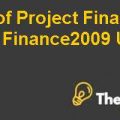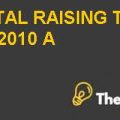
1. Issues and Objectives
Lawson has been facing liquidity issues, because it extensively relied on trade debts in order to finance its working capital. However, the major supplier of Lawson merchandise is Forsyth Wholesale Ltd. (FWL) and total trade debts of $217,236/- are payable to FWL out of which 85% debts have been overdue. Meanwhile, as per the terms of the debt Lawson has to pay a penalty of 13.50% of the overdue trade debts which is deteriorating Lawson’s profitability and causing cash flow shortages. Further, since Lawson business is a seasonal business, hence, he needed an additional line of credit in order to finance the seasonable variation in cash flow requirements.
2. Case Analysis
i. Ratio analysis
a. Profitability Ratios
Net Earnings
The net earnings ratio of Lawson’s is volatile and fluctuates each year and these fluctuations in net profit margins are due to the seasonal business.However, the net earning margin remains within the limit of 2.6% to 3.3% and still the lowest range of Lawson’s net earnings margin is higher than the industry ratio of 2.1%, which means that Lawson is performing better than the industry norms.
Return on Equity
Further the pre-calculated ratios in exhibit 3 show that the Lawson’s have successfully generated the return on equity percentage of 83.5% in the year 2000, which has grown to 241% in the year 2002, whereas the industry return on equity is 31.6%, which means that Lawson has outperformed the market in terms of returns on equity investment. However, the significant growth in return on equity ratio is due the constant decrease in capital led by continuouswithdrawals by Mackay, but still the return on equity of 83.5% in the year 2000 is much higher than the industry returns of 31.6%.
b. Liquidity Ratios
Current Ratio
The current ratio is continuously decreasing over the last four year period, and in the year 2003 this ratio shows that using the liquid assets Lawson can afford to pay $1.02 for each $1 of its current liabilities. However, the industry norms show that this ratio should be around $1.8 of liquid assets for every $1 of current liabilities, therefore, the current ratio confirms that Lawson is facing liquidity problems.
Acid Test Ratio
Acid test ratio is same as is the current ratio except that it excludes the inventory because inventory is a trading item and takes longer time to sell.Meanwhile, the acid test ratio has been between 0.07 and 0.11 which is quite below the industry acid test ratio. Further, this low ratio is because Lawson hasa high level of investment in inventory, hence, Lawson is significantly exposed to liquidity problems and it might fail to pay off its current liabilities when they fall due.
c. Efficiency Ratios
Age of Receivable
Lawson has excessively tightened the credit controls and currently it is recovering its trade debts within 7 days of the sale and previously the credit for customers was even 2 days. Meanwhile, the average receivable collection period is 19 days, which means that Lawson is effectively managing its receivables but this excessive credit control may lead to dissatisfied customers.
Age of Inventory
Lawson takes 156 daysto turn over its inventory, meanwhile; the Lawson has not been able to manage its inventory because the inventory turnover period has been increasing over the last four year period which leads to high capital tied up in unsold inventory. Further, the inventory age for inventory in the industry is 25/7 days, which, means that Lawson is not managing its inventory efficiently.
Age of Payables
Trade payable period of Lawson has also been increasing over the last four year period and even this debtors’ payable period has doubled in the current year to reach 154 days.However, this longer payable period means that Lawson excessively relies on purchase credits to finance its working capital which will deteriorate its relations with the suppliers
d. Stability
Net Worth/Total Assets
Net worth to total asset ratio measures that how much of the business assets are financed by the equity capital. Further, the net worth to total asset ratio is nil in the year 2003 because the balance sheet shows the negative value of equity portion.
Interest Coverage
Interest coverage ratio of Lawson is very low because its profits before interests cannot cover the interest even twice. However, this low level of interest cover is due to the 13.5 penalty on overdue trade payables which are leading to the decline in profitability.
e. Growth
However, the sales revenue is increasing year by year, which means that Lawson has the growth potential and similarly the net revenues also growing except during the year 2001-02. Further, the total assets of the company have grown by 45.6% in the year 2003 which means that Lawson is growing and investment in capital assets is being made................
This is just a sample partial case solution. Please place the order on the website to order your own originally done case solution.













